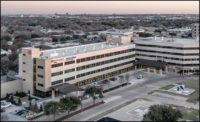
When UMass Memorial Health Care began planning a demolition/renovation to fit out 14,000 sq ft of mixed space for a new clinic, the assumption was that an additional 80 to 120 tons of cooling capacity would be needed. But in the current economic climate, the administration had to ask: Is there an effective
alternative solution? From assessing the infrastructure to the effects of rebalancing the entire chilled water system, see what went into their final conclusion and plan of action.
Mass Memorial Health Care (UMMHC) is the largest health care system in central and western Massachusetts, the clinical partner of the University of Massachusetts Medical School, and fully accredited by the Joint Commission. In total, UMMHC hospitals have 1,111 beds, treating 58,762 inpatients annually and more than one million outpatient visits. It provides the region with specialists nationally acclaimed for their work in areas such as cardiology, orthopedics, cancer, newborn intensive care, children’s services, women’s services, emergency medicine, and trauma.
To keep pace with the health care needs of the UMMHC organization, the Capital Planning & Management (CP&M) group faces renovation challenges on a daily basis. One such challenge was the complete renovation from demolition to fit out of their 14,000 sq ft mixed use space for a new Ophthalmology Clinic.
While the new LEED® Commercial Interiors (CI) ophthalmology space would be designed to fit into existing hospital space, there was a perception that an additional 80- to 120-ton cooling capacity was required to accommodate the project. For the CP&M group, this request for additional cooling capacity needed to be challenged based on available project funding, the existing infrastructure, and responsible management by the CP&M group.
With any renovation program, both the CP&M group and the operation and maintenance (O&M) group were involved with coordinating HVAC capacity and performance history to make sure the HVAC infrastructure could support the hospital’s health care program update.
Historically, the two existing central chilled water central plants at Hahnemann Hospital, part of the UMMHC system, in Worcester, MA, struggled to maintain the required air conditioning demands on hot, humid days when outdoor temperatures approached design conditions. For the initial design phase of this ophthalmology facility, there was a need to challenge this request for additional cooling capacity based on past central plant performance.
EVALUATING THE PROCESS
Prior to beginning the design engineering of a new 120-ton chiller for this job, a meeting was held with the two groups to better document the facility infrastructure and discuss concerns, issues, and suggestions for moving forward. The O&M group indicated that the existing space to be renovated included four-pipe fancoil units working in conjunction with a central AHU system with an overall capacity of 30 tons. Moreover, the vacant shell space had not been incorporated into the total heat gain load of the building, and the existing equipment was noted to be in poor condition and in need of replacement. The most troubling fact was that while air conditioning of space (facility wide) continued to increase, there had not been an expansion to the chilled water capacity since the 1980s.Hahnemann Hospital, like most hospitals, expanded central chilled water systems as it grew in size and modernized the facility. It is not uncommon to find health care chiller plants containing a chiller(s) that was installed in the late 1960s and 1970s along with newer chillers to accommodate infrastructure growth 15 or 20 years later. There is not a lot of historical data available on the useful service life for a chiller, but with a good PM program, chillers can continue to operate for 30 years, if not longer. This extended life doesn’t mean chillers will operate efficiently and/or at peak performance over the years, but they will produce chilled water with some reliability during that period.
Unlike commercial buildings and many industrial buildings, the health care industry is in it for the long haul, and while many hospitals have been bought, sold, or merged, these facilities continue to serve the community, so the facility infrastructure needs to continue to contribute too.
Hospitals, as well as other institutions such as educational organizations, invest in infrastructure master plans and will even update these plans every eight to ten years, but seldom do these institutions invest in tuning up the infrastructure that supports the master plans. Somehow, the funding just hasn’t been made available to keep HVAC systems operating efficiently, which leads to operating inefficiencies, unexpected equipment failures, and unscheduled interruption of services to the buildings they serve. These deficiencies are compounded by a loss of building system knowledge over time as operation personnel leave and infrastructure documents are not kept current (if they are not simply lost).
As UMMHC Hospitals have grown and/or renovated, consulting engineers have been contracted to provide design and engineering services. Using various design engineers at most hospitals over time can compound the infrastructure performance because of fragmented knowledge of the infrastructure and its performance, and UMMHC is no exception. Maintaining the same consulting firm for infrastructure knowledge is not a common practice. As a result, the additions and alterations may be engineered without clearly understanding the overall infrastructure performance. Each project, along with the addition of multiple standalone HVAC systems, tends to cloud the status of HVAC infrastructure performance and routinely compromises the goal of having a holistic mechanical system to serve the health care site.
A perfect example of this is when an existing central chilled water system is not expanded in capacity, but instead the facility chooses to add cooling capacity by decentralized this infrastructure based on the funding of a specific construction project. All too often, first cost and fast-track schedules will result in supplemental cooling systems in the form of separate air cooled chillers not connected to the central plant and individual direct expansion cooling coils installed in new AHUs.
Over time, the infrastructure and its original design intent to have central chilled water cooling becomes fragmented, resulting in less than efficient air conditioning performance and system reliability, plus an increase in O&M needs. Along with these supplemental systems will be a division in record documentation and interpretation of how the overall chilled water infrastructure is to function. Adding to this dilemma, years will go by and consulting engineers will have a preference to provide new air conditioning systems rather than risk the chance of connecting their design into an existing chilled water system that has by now become a misunderstood infrastructure service.
STOPPING TO ASSESS THE INFRASTRUCTURE
Today, with hospitals struggling to operate efficiently, each new renovation program or new addition brings financial and engineering challenges to infrastructure management. It was this point in time with the LEED CI ophthalmology renovation project that CP&M group chose to take a fresh and separate look at its overall air conditioning infrastructure capacity in parallel with the design team effort. While the design team focused on their ophthalmology renovation, UMMHC contracted RDK Engineers, an Andover, MA-based engineering firm to revisit the central chiller plant infrastructure basis of design with the goal of avoiding investing in a separate air cooled chiller for the renovation project.Historically, it was believed the existing problematic Hahnemann chiller plant could not accommodate any further cooling load additions because the central system could not keep up with the current load demands. The existing chilled water system was made up of two-steam absorption chillers (circa 1960s) located in a penthouse, cross-connected with a centrifugal chiller (circa 1980s) in the basement. The CP&M and O&M groups wanted to challenge the perception that the chiller capacity just wasn’t there by having RDK study the existing conditions before the hospital committed funds to the addition of a 120 ton, standalone chiller.
The study began with the data collection process, inventorying all the central AHUs, the chillers, cooling towers, pumps, and automatic temperature control (ATC) sequences of operation. Based on the findings and RDK experience with how health care chiller plants have been designed, they determined the following:
- The majority of central plants going back to the ’60s and ’70s were built with redundancy of some capacity. This redundant capacity would range from 50% to 100% additional capacity and was usually closer to the 100%.
- Not all parts of hospital were air conditioned back in the ’60s and ’70s, but most central air conditioning units were 100% outdoor air which was a significant cooling load on the chiller plant.
- After the energy crisis of the 1970s, new central AHUs were designed for higher ventilation rates (more cfm than the unit it was replacing) but usually with less outdoor air than the original central AHU.
- When a second chiller plant was added, it was not known if there was extra cooling capacity with this new unit, but RDK believed engineered chiller selections could be counted on to be conservatively selected.
- With an emphasis on construction project first cost in the ’80s and ’90s, hospitals would frequently opt for less expensive air cooled split systems to avoid connecting to the central chiller plant. This would indicate the hospital’s existing chiller capacity had not been challenged by a need for more capacity. Instead, existing chilled water load was probably reduced as existing AHUs were downsized or removed based on the addition of new central AHUs.
- Over time, with little investment in tuning up infrastructure, the two chiller plants were now candidates for a rebalancing of their entire central water systems.
As part of data collection, RDK used a series of benchmarks to assess the chilled water system and the central air systems, as well as inventorying the connected cooling loads. Based on this data analysis, RDK determined the following:
- The overall sq ft/ton of cooling was 315 sq ft/ton with RDK benchmarking it to their assessment of 350 sq ft/ton being a reasonable cooling demand if the systems were rebalanced and retrocommissioned.
- This benchmarking indicated to them that there could be 70 tons space cooling capacity available. This also took into account the proposed ophthalmology renovation, which RDK did not consider as an additional cooling requirement because the space was already being air conditioned.
- The individual area sq ft/ton also indicated to RDK that the chiller plant should not be at peak capacity, even though with current conditions the hospital was not able to maintain overall space comfort.
- The overall cfm/sq ft/ton was approximately 1.4 cfm/sq ft with RDK benchmarking it to their assessment of 1.2 cfm/sq ft. This indicated to them that there could be 15% surplus cooling capacity via the central air systems, which was in line with the 10% chiller plant assessment.
- The individual area cfm/sq ft ranged from 0.9 cfm/sq ft to as much as 2 cfm/sq ft, and based on health care application, these values reinforced RDK’s belief that the dual central chiller plant should not be at peak capacity.
A CHILLING SOLUTION
In the summer of 2009 RDK contracted Thomas-Young & Associates (T-Y&A), a Massachusetts-based air and water balancing firm, to rebalance the entire chilled water system. In the process, T-Y&A found the cross-connection of the two 1960s steam absorption units with the 1980s centrifugal chiller to have the bypass valve controls incorrectly set, resulting in chilled water flow deficiencies.In addition, the chilled water flows through the steam absorption units were not set for their design flows also resulting in chilled water flow deficiencies. By rebalancing the entire chilled water distribution to each AHU and fancoil units, the central system would basically receive a tune-up that would improve central plant infrastructure while providing the overall cooling capacity needed to serve the entire hospital.
During the summer, after the cross connections had been corrected but prior to the entire chilled water system being rebalanced, a noticeable improvement of the central chilled water system performance was observed on a hot day close to design conditions. This feedback from the O&M group on that day reinforced the assessment and report completed by RDK for UMMHC. The next step was to finish the rebalancing of the entire chilled water system.
SUMMARY
In an economic downturn but still with a need to continue to improve health care services, UMMHC’s CP&M group recognized they needed to take the initiative to assess all their option when proceeding with a new capital project if they were going to be truly financially responsible in these challenging times. They recognized that requests for additional cooling were common but not always needed.After investing in an engineering study that would run in apparel with their LEED CI certification ophthalmology renovation, it was determined that the existing central chiller plant could handle the air conditioning needs of this renovation job. The benefits to rebalancing the entire central chilled water system was that they could afford the cost of furnishing and installing a 120-ton air cooled chiller budgeted at around $200,000 first cost and an estimated $14,000 annual maintenance cost. The energy engineering cost equated to a three-month ROI, a more efficient infrastructure operation, and a chilling process cast study. ES





